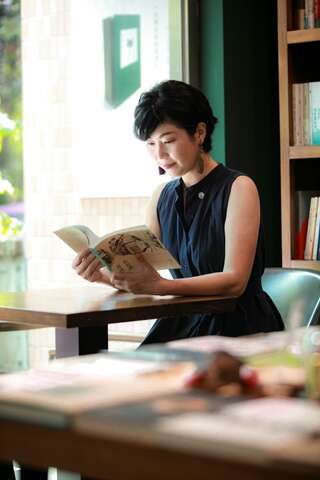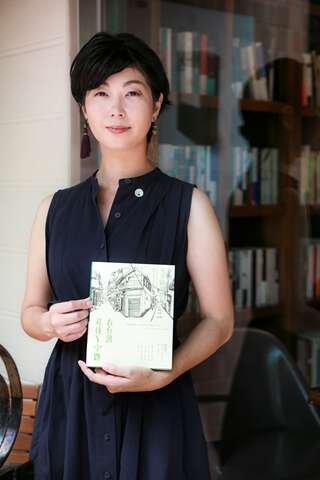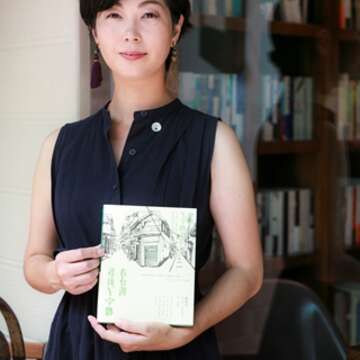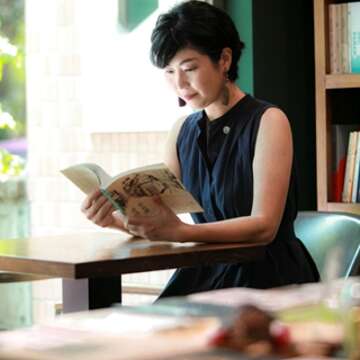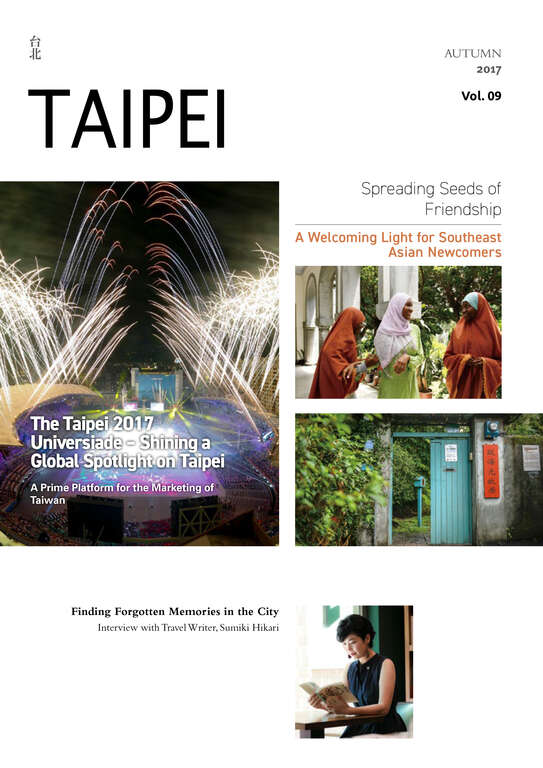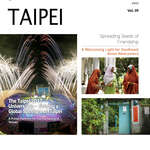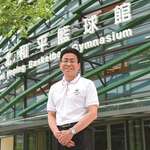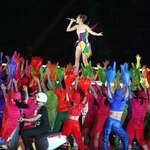Post date:2017-09-13
1865
Finding Forgotten Memories in the City
Interview with Travel Writer, Sumiki Hikari
Article|Jiang Xinying Photos|Shi Chuntai
Taipei is not a big city. An MRT train at 35 km per hour takes just one hour to travel its longest route – the Tamsui-Xinyi Line (淡水信義線). Open the MRT map and you will see the brown, red, green, orange and blue routes looking like five tangled serpents. Day after day, these lines slide underground quietly, taking in and spitting out millions of passengers. The scenery that Taipeiers experience from day to day never changes from stop to stop, and a traveler’s urban movement is condensed into a two-dimensional activity. Looking for a Fork in the Road in Taiwan (在台灣尋找Y字路), written by Sumiki Hikari (栖來光), offers a new angle on exploring Taipei. Following the old city map, the book allows you to walk into a space that is the intersection of old and new worlds. What those long-lost memories are trying to tell you is: Taipei, though not a big city, has a great depth and richness.
History Jumps out from Every Corner
On a mid-summer day in August, I met Sumiki Hikari at Editors Books & Café (欒樹下的書房) on Wenzhou Road (溫州路). She had just come back from Japan and showed me the Historical Map* of Taipei on her cell phone. She pointed out the neighborhood known as Showa-cho (昭和町) in the Japanese Era, which is now bordered by Qingtian (青田街), Yongkang (永康街) and Wenzhou Streets (溫州街). This used to be the residential area for faculty and staff from Taipei Imperial University (臺北帝國大學). Top academic researchers of all fields gathered and lived here, reading or writing under eaves of tile. They took their teaching seriously and enjoyed each other’s company, and so, an atmosphere of culture and humanity formed and has lingered until now. By looking at the remaining Japanese-style wooden houses, one can imagine what it was like to live back then. These old houses are a window into a misty history. But, instead of focusing merely on these ancient dwellings, Sumiki Hikari fixes her gaze on the seemingly normal but hidden street corners: forks in the road, or as the Taiwanese say: “san cha lu” (三叉路, junction of three roads) or “san jiau chuon” (三角窗, corner window).
The establishment of a fork in the road usually has something to do with waterways, railway tracks or urban projects. Looking for a Fork in the Road in Taiwan introduces 45 such forks, the routes that lead to them, and the buildings that surround them. Throughout the Qing Dynasty, the Japanese Era and the post-war period, streets in Taipei evolved, inheriting different cultural strengths and adapting to generational requirements. But as urban development carried on, traces of this history gradually disappeared. Sumiki Hikari has taken old maps, photos, and cultural and historical data of Taiwan and Japan and compared it all with the present day. Her eyes are like a camera, and her writing is the script for a film of the old days that plays before our eyes. Sumiki Hikari says, “A fork in the road is just one small street corner but has so many layers of history to reveal. It’s rather special.”
Note: This is an App developed by the Academia Sinica Center for Digital Culture (中央研究院數位文化中心). It displays old maps and photos from 1895 to 1974, and compares them with current Google map and street views, thus allowing users to see the changes in Taipei over the years.
Sumiki Hikari’s Everyday Traveling
Looking for a Fork in the Road in Taiwan is an interesting work of literature and history. Her movie production experience shows in the way she makes the reader see what she is describing. Her hand-draw maps and selected photos further add feeling of warmth and solidity to this book. Looking at it from a different angle, the book is an advanced travel guide for exploring time and space. Most travelogues simply focus on food, scenery, landmarks or other attractions worth visiting, but Sumiki Hikari believes: “Everyone has different memories and experiences. If two people are facing the same spot, they’ll connect to it differently.” She has spent years exploring hundreds of forks in the road, and accidently discovered some unknown aspects of Taiwanese and Japanese history. She even found a connection between her hometown, Yamaguchi ken (山口縣) and Taiwan. “In this book, there are stories of Taiwan, and stories of Japan. As a Japanese writer, what kind of memories do I have? How did I become who I am?” She stands on the street of a foreign country, but she sees images of her hometown. Whether searching, photographing, hand-drawing, and writing, she has gradually come to realize that, “Every day one is traveling, and, wherever you travel to, that place is your home. In life, you experience ‘rebirth’ every day, and traveling is the process whereby you get to know yourself all over again.”
In 2006, Sumiki Hikari met a fork in the road and chose the path that led to Taiwan. She saw the scenery extending ahead, the busy traffic in front of her, and also the rivers flowing as in the olden times, with gentle breezes blowing over the waterways. Images of the past appear in her writing. “Now, I’m happy working every day.” She wants to introduce her hometown Yamaguchi ken to Taiwanese readers, and also write about Taiwan’s festivals and customs, handicrafts and movies. Such a passion as hers will shine through for many years to come.
Introduction of the Writer
Sumiki Hikari is a freelance writer, who graduated from the Faculty of Fine Arts, Kyoto City University of Arts (京都市立藝術大學美術學部). In 2006, she moved to Taipei and writes with a unique perspective about what she has seen and heard in Taiwan and Japan. Her articles have appeared in her personal blog, Taipei Story (台北物語~Taipei Story), and in other publications as well. Her topics include news, history, arts, handicrafts, movies and cultural issues. Her book Looking for a Fork in the Road in Taiwan was published in 2017.
https://taipeimonogatari.blogspot.tw
Writer’s Recommendations
Salty Soy Milk
Sumiki Hikari says she likes typical Taiwanese cuisine very much, and particularly, traditional Chinese breakfast “salty soy milk” is her favorite food. First you put a pinch each of tsa tsai (pickled mustard, 榨菜), cai fu (dried radish, 菜脯) and dried shrimp in a bowl, then you add soy sauce, sesame oil, and vinegar (proportions tend to vary depending on the eatery). Next you pour hot thick soy milk over these ingredients and top it all with chopped green onions and “youtiao” (deep-fried dough stick, 油條). According to Sumiki Hikari, it tastes a little like steamed eggs.
Museum of Anthropology of NTU
This museum is situated on the NTU campus, attached to the Department of Anthropology (人類學系). Its collection was mainly inherited from the Specimen Room created for the “Course on the Study of Local Peoples” (土俗人種學講座) at Taipei Imperial University in the Japanese Era. The main specimens are divided into two main categories: ethnology and anthropology. In addition to holding such precious historical objects and materials, the broad beautiful NTU campus is simply a great place to take a walk!
Address:
No. 1, Sec 4, Roosevelt Rd., Daan Dis., Taipei City
Open Hours:
10:00 ~ 16:00, Mon. ~ Sat., (Saturday hours extend from 09:00 to 17:00)
Closed on Tuesdays and national holidays.Gallery
Popular articles
 TAIPEI QUARTERLY 2017 AUTUMN Vol.09
TAIPEI QUARTERLY 2017 AUTUMN Vol.09 The Taipei 2017 Universiade – Shining a Global Spotlight on Taipei (TAIPEI QUARTERLY 2017 AUTUMN Vol.09)
The Taipei 2017 Universiade – Shining a Global Spotlight on Taipei (TAIPEI QUARTERLY 2017 AUTUMN Vol.09) Mayor Ko Wen-je – Indefatigable in Transforming Taipei Perfect Finish for the Summer Universiade (TAIPEI QUARTERLY 2017 AUTUMN Vol.09)
Mayor Ko Wen-je – Indefatigable in Transforming Taipei Perfect Finish for the Summer Universiade (TAIPEI QUARTERLY 2017 AUTUMN Vol.09) Dreams and Realization, Behind-the-Scene Heroes of the Universiade (TAIPEI QUARTERLY 2017 AUTUMN Vol.09)
Dreams and Realization, Behind-the-Scene Heroes of the Universiade (TAIPEI QUARTERLY 2017 AUTUMN Vol.09) Let's Give a Cheer for the Taipei 2017 Universiade Grand Opening! (TAIPEI QUARTERLY 2017 AUTUMN Vol.09)
Let's Give a Cheer for the Taipei 2017 Universiade Grand Opening! (TAIPEI QUARTERLY 2017 AUTUMN Vol.09) So Inspiring, Taipei! Universiade Featured Venues Take on a New Look (TAIPEI QUARTERLY 2017 AUTUMN Vol.09)
So Inspiring, Taipei! Universiade Featured Venues Take on a New Look (TAIPEI QUARTERLY 2017 AUTUMN Vol.09)
 Finding Forgotten Memories in the City (TAIPEI QUARTERLY 2017 AUTUMN Vol.09)
Finding Forgotten Memories in the City (TAIPEI QUARTERLY 2017 AUTUMN Vol.09)